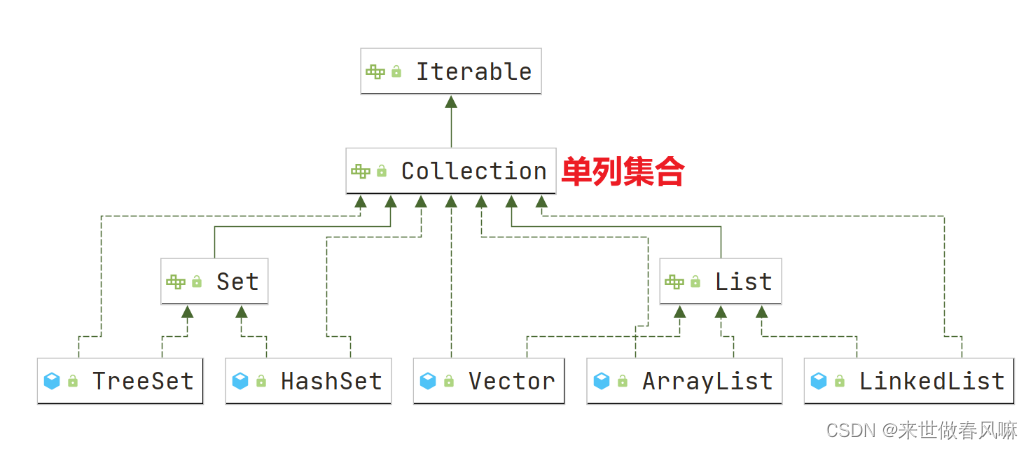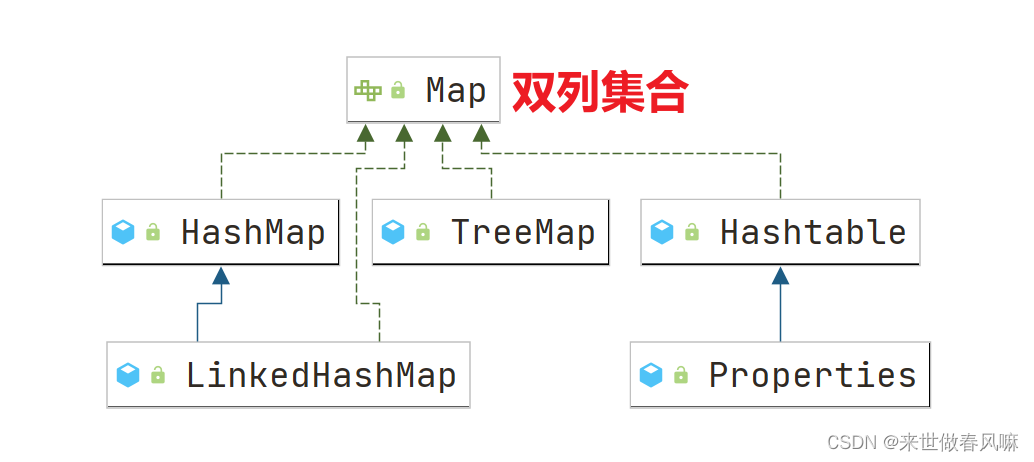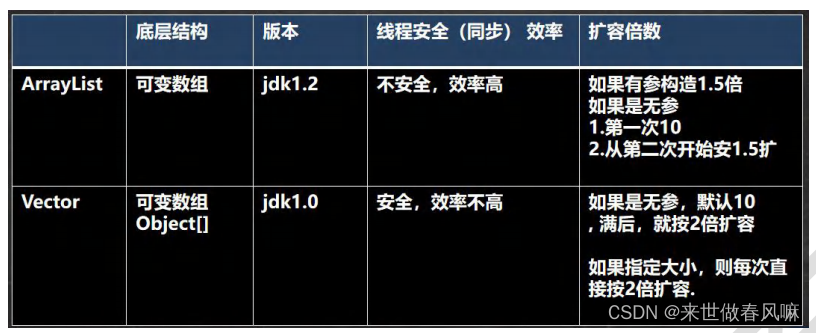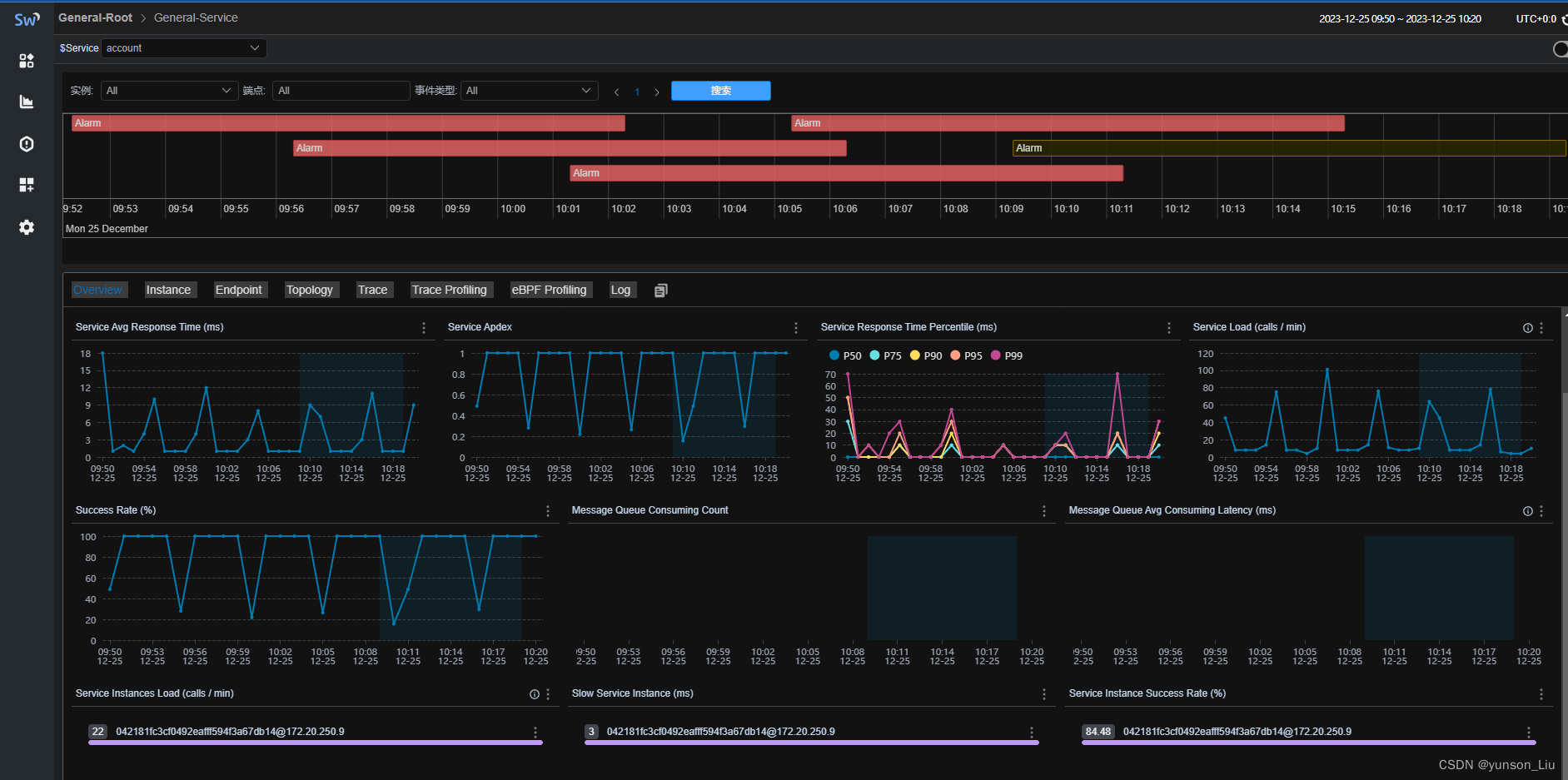一、集合框架体系
集合:
(1)可以动态保存任意多个对象。
(2)提供了一系列方便的操作对象的方法:add、remove、set、get等。
二、Collection
1. Collection 接口常用方法
(1)add:添加单个元素
(2)remove:删除指定元素
(3)contains:查找元素是否存在
(4)size:获取元素个数
(5)isEmpty:判断是否为空
(6)clear:清空
(7)addAll:添加多个元素
(8)containsAIl:查找多个元素是否都存在
(9)removeAll:删除多个元素
2. Collection 接口遍历元素方式1,使用 Iterator(迭代器)
(1)Iterator 对象称为迭代器,主要用于遍历 Collection集合 中的元素。
(2)所有实现了 Collection接口 的集合类都有一个 iterator() 方法,用以返口一个实现了Iterator接口 的对象,即可以返回一个迭代器。
(3)Iterator 仅用于遍历集合,lterator 本身并不存放对象。
public class Test {public static void main(String[] args) {ArrayList<Integer> list = new ArrayList<>();list.add(1);list.add(2);list.add(3);// list.iterator() 重置迭代器,可重复Iterator<Integer> iterator = list.iterator();while (iterator.hasNext()) {Integer next = iterator.next();System.out.println(next);}}
}
3. Collection 接口遍历元素方式2,for循环增强
增强 for 循环,可以代替 iterator 迭代器,特点:增强 for 本质就是迭代器。只能用于遍历集合或数组。
public class Test {public static void main(String[] args) {ArrayList<Integer> list = new ArrayList<>();list.add(1);list.add(2);list.add(3);for (Integer e : list) {System.out.println(e);}}
}
三、List
1. List 接口基本介绍
(1)List 接口是 Collection 接口的子接口。
(2)List 集合类中元素 有序(即添加顺序和取出顺序一致)、且 可重复。
(3)List 集合中的每个元素都有其对应的顺序索引,即 支持索引。
(4)List 容器中的元素都对应一个整数型的序号记载其在容器中的位置,可以根据序号存取容器中的元素。
2. List 集合里添加了一些根据 索引 来操作集合元素的方法
(1)void add (int index, Object ele):在 index 位置插入 ele 元素。
(2)boolean addAll (int index, Collection eles):从 index 位置开始将 eles 中的所有元素添加进来。
(3)Object get (int index):获取指定 index 位置的元素。
(4)int indexOf (Object obj):返回 obj 在集合中首次出现的位置。
(5)int lastlndexOf (Object obj):返回 obj 在当前集合中末次出现的位置。
(6)Object remove (int index):移除指定 index 位置的元素,并返回此元素。
(7)Object set (int index, Object ele):设置指定 index 位置的元素为 ele,相当于是替换。
(8)List subList (int fromlndex,int tolndex):返回从 fromlndex 到(tolndex -1)位置的子集合。
public class Test {public static void main(String[] args) {List<String> list = new ArrayList<>();list.add("乔峰");list.add("段誉");list.add(1, "虚竹");list.add("Tom");System.out.println(list); // [乔峰, 虚竹, 段誉, Tom]List<String> list2 = new ArrayList<>();list2.add("Jack");list2.add("Tom");list.addAll(1, list2);System.out.println(list); // [乔峰, Jack, Tom, 虚竹, 段誉, Tom]System.out.println(list.get(1)); // JackSystem.out.println(list.indexOf("Tom")); // 2System.out.println(list.lastIndexOf("Tom")); // 5list.remove(5);System.out.println(list); // [乔峰, Jack, Tom, 虚竹, 段誉]list.set(2, "Mike");System.out.println(list); // [乔峰, Jack, Mike, 虚竹, 段誉]System.out.println(list.subList(0, 2)); // [乔峰, Jack]}
}
四、ArrayList(P509)
1. ArrayList的注意事项
(1)ArrayList 可以加入 null,并且多个。
(2)ArrayList 是由数组来实现数据存储的。
(3)ArrayList 基本等同于 Vector。ArrayList 是线程不安全(执行效率高),在多线程情况下,不建议使用 ArrayList。
2. ArrayList的底层操作机制 源码 分析(P510)
(1)ArrayList 中维护了一个 Object 类型的数组,transient Object[] elementData(transient 表示该属性不会被序列化)。
(2)当创建 ArrayList 对象时,如果使用的是无参构造器,则初始 elementData 容量为 0。第一次添加,则扩容 elementData 为 10。如果需要再次扩容的话,则扩容 elementData 为1.5 倍。
(3)如果使用的是指定大小的构造器,则初始 elementData 容量为指定大小,如果需要扩容,则直接扩容 elementData 为1.5倍。
public class ArrayList_<E> {transient Object[] elementData;private int size;protected transient int modCount = 0;private static final int DEFAULT_CAPACITY = 10;private static final Object[] DEFAULTCAPACITY_EMPTY_ELEMENTDATA = {};// 无参构造public ArrayList_() {// 创建一个空的数组this.elementData = DEFAULTCAPACITY_EMPTY_ELEMENTDATA;}public ArrayList_(int initialCapacity) {if (initialCapacity > 0) {this.elementData = new Object[initialCapacity];} }public boolean add(E e) {ensureCapacityInternal(size + 1); // Increments modCount!!// 在 elementData[size] 赋值,并且size++elementData[size++] = e;return true;}private void ensureCapacityInternal(int minCapacity) {ensureExplicitCapacity(calculateCapacity(elementData, minCapacity));}private void ensureExplicitCapacity(int minCapacity) {// 操作次数modCount++;// overflow-conscious code// 判断是否扩容,如果elementData数组大小不够就扩容if (minCapacity - elementData.length > 0){grow(minCapacity);}}private static int calculateCapacity(Object[] elementData, int minCapacity) {if (elementData == DEFAULTCAPACITY_EMPTY_ELEMENTDATA) {return Math.max(DEFAULT_CAPACITY, minCapacity);}return minCapacity;}private static final int MAX_ARRAY_SIZE = Integer.MAX_VALUE - 8;// 扩容方法private void grow(int minCapacity) {// overflow-conscious codeint oldCapacity = elementData.length;// 扩容为1.5倍int newCapacity = oldCapacity + (oldCapacity >> 1);if (newCapacity - minCapacity < 0){newCapacity = minCapacity;}// 防止超过最大值2147483639if (newCapacity - MAX_ARRAY_SIZE > 0){newCapacity = hugeCapacity(minCapacity);}// minCapacity is usually close to size, so this is a win:// Arrays.copyOf 可以保留原先的数据,并扩容elementData = Arrays.copyOf(elementData, newCapacity);}private static int hugeCapacity(int minCapacity) {if (minCapacity < 0){// overflowthrow new OutOfMemoryError();}return (minCapacity > MAX_ARRAY_SIZE) ?Integer.MAX_VALUE :MAX_ARRAY_SIZE;}
}
五、Vector(P513)
1. Vector 的基本介绍
(1)Vector 类的定义说明
public class Vector<E>extends AbstractList<E>implements List<E>, RandomAccess, Cloneable, java.io.Serializable
(2)Vector 底层也是一个对象数组 protected Object[] elementData;
(3)Vector 是线程同步的,即线程安全,Vector 类的操作方法带有 synchronized。
(4)在开发中,需要线程同步安全时,考虑使用 Vector。
2. Vector 的底层操作机制源码分析
Vector 扩容源码类似于 ArrayList
public class Vector_<E> {protected Object[] elementData;protected int capacityIncrement;protected transient int modCount = 0;protected int elementCount;public Vector_() {this(10);}public Vector_(int initialCapacity) {this(initialCapacity, 0);}public Vector_(int initialCapacity, int capacityIncrement) {super();if (initialCapacity < 0){throw new IllegalArgumentException("Illegal Capacity: "+initialCapacity);}// 初始化数组this.elementData = new Object[initialCapacity];this.capacityIncrement = capacityIncrement;}public synchronized boolean add(E e) {modCount++;ensureCapacityHelper(elementCount + 1);elementData[elementCount++] = e;return true;}private void ensureCapacityHelper(int minCapacity) {// overflow-conscious code// 判断是否扩容if (minCapacity - elementData.length > 0){grow(minCapacity);}}private void grow(int minCapacity) {// overflow-conscious codeint oldCapacity = elementData.length;// newCapacity = oldCapacity + oldCapacityint newCapacity = oldCapacity + ((capacityIncrement > 0) ?capacityIncrement : oldCapacity);if (newCapacity - minCapacity < 0){newCapacity = minCapacity;}elementData = Arrays.copyOf(elementData, newCapacity);}
}
六、LinkedList(P515)
1. LinkedList 说明
(1)LinkedList 底层实现了双向链表和双端队列特点。
(2)可以添加任意元素(元素可以重复),包括 null。
(3)线程不安全,没有实现同步。
2. LinkedList 的底层操作机制
(1)LinkedList 底层维护了一个双向链表。
(2)LinkedList 中维护了两个属性 first 和 last 分别指向首节点和尾节点。
(3)每个节点(Node对象),里面又维护了 prev 、next 、item 三个属性,其中通过 prev 指向前一个,通过 next 指向后一个节点。最终实现双向链表。
(4)所以 LinkedList 的元素的添加和删除,不是通过数组完成的,相对来说 效率较高。
3. LinkedList 源码 解读(P516)
public class LinkedList_<E> {transient int size = 0;protected transient int modCount = 0;transient Node<E> first;transient Node<E> last;private static class Node<E> {E item; // 存放数据Node<E> next;Node<E> prev;Node(Node<E> prev, E element, Node<E> next) {this.item = element;this.next = next;this.prev = prev;}}public boolean add(E e) {linkLast(e);return true;}void linkLast(E e) {final Node<E> l = last;final Node<E> newNode = new Node<>(l, e, null);last = newNode;if (l == null) {first = newNode;} else {l.next = newNode;}size++;modCount++;}public E remove() {return removeFirst();}public E removeFirst() {final Node<E> f = first;if (f == null) {throw new NoSuchElementException();}return unlinkFirst(f);}private E unlinkFirst(Node<E> f) {// assert f == first && f != null;final E element = f.item;final Node<E> next = f.next;f.item = null;f.next = null; // help GCfirst = next;if (next == null) {last = null;} else {next.prev = null;}size--;modCount++;return element;}
}
七、ArrayList和LinkedList比较(P517)
(1)如果我们改查的操作多,选择 ArrayList。
(2)如果我们增删的操作多,选择 LinkedList。
(3)一般来说,在程序中,80%-90%都是查询,因此大部分情况下会选择 ArrayList。








